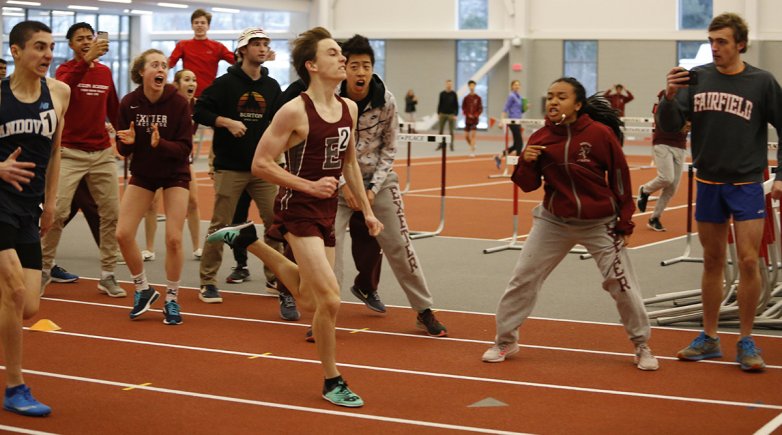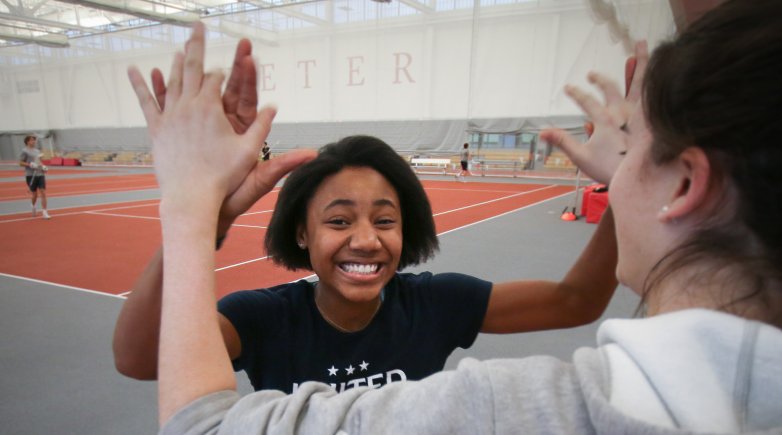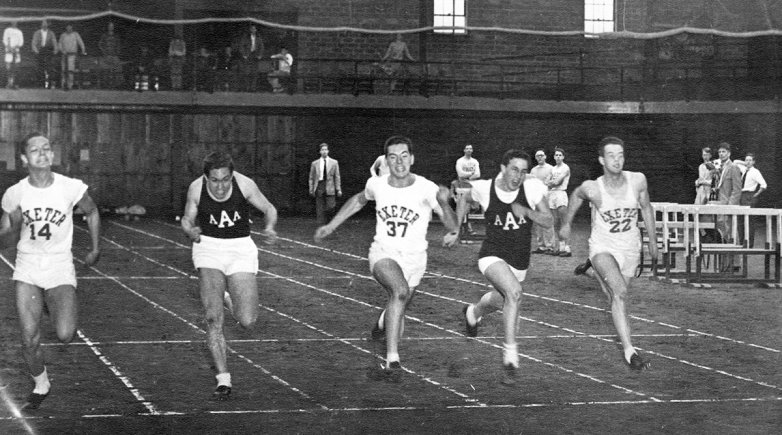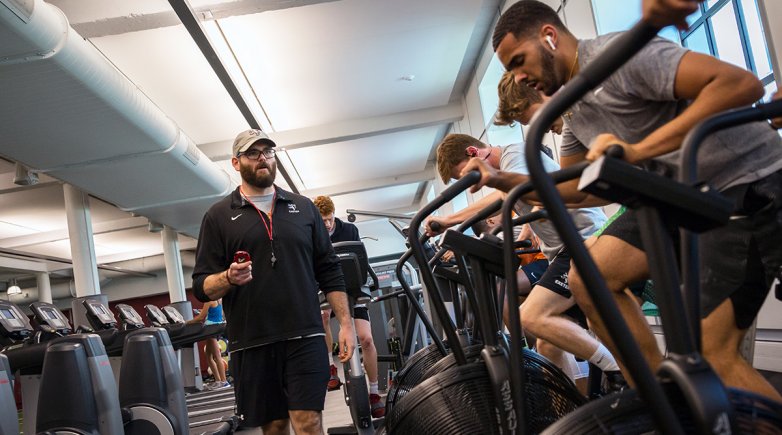Back on track
Big Red athletes thrive in the first year of the William Boyce Thompson Field House.
Will Coogan ’20 charges around the final turn, the narrow lead he has nursed throughout the race fading. The last 50 meters of the boys mile against his Andover rival seem like they might be 50 too many.
Then help arrives. Coogan’s Exeter teammates, the sprinters and jumpers and hurdlers, flood the final straightaway to urge him forward. A lovely racket rises around the finish line. A home-field advantage absent at Exeter for years kicks in.
With those friends and teammates providing the final push, Coogan fends off his Big Blue pursuer by a whisker. It turns out to be one of the few suspenseful moments during an Exeter/Andover winter track runaway at William Boyce Thompson Field House on this February afternoon. Playing host to their historic rivals on campus for the first time since 2011, the Big Red boys and girls indoor track teams sweep to comfortable victories.
The occasion — let alone the impressive results — is testimony to the new field house’s impact on Exeter’s student-athletes. The track teams went five years between home indoor meets, foiled by a beloved but decaying Thompson Cage deemed unsafe for competition. Just a year removed from running sprints in hallways and heaving shot in an old squash court, Big Red is back on track.
“The word ‘trust’ comes to mind,” says Hilary Coder Hall, the teams’ longtime coach and a physical education instructor at the Academy since 1983.
The team “had to just ignore the fact that they knew we weren’t doing the training that we were supposed to do and blindly trust that it was going to be OK.”
“Pride” is the word that pops into Hannah Brown’s head. The senior captain says having a space as “magnificent” as the new field house has drawn the teams closer together and lifted the level of pride the athletes have in the program. As solitary as toeing a starting line in competition can be, the team dynamic is very real during training.
“I’ll be doing hurdles and a distance runner will be running past me and cheering for me, or I can cheer for the throwers or the people who are doing jumps. It’s really awesome,” she says.

The Thompson Field House opened in January 2018. The 84,574-square-foot building features a six-lane, 200-meter track oval that expands to eight lanes at the straightaway for sprints and hurdles. The dedicated NCAA-regulation areas for shot put, high jump, long jump, triple jump and pole vault allow for safe, simultaneous training and competition.
Beyond track and field, the $40.02 million facility accommodates four tennis courts, a multipurpose infield, two batting cages, bleacher seating for 500 spectators and an 8,000-square-foot wrestling center overlooking the oval on the mezzanine level. Magnificent, indeed.
“When I first walked into this building, it brought tears to my eyes,” Brown says.
The cost of the building — covered by the generosity of Exeter donors — wasn’t the only price; to make room for the field house, the venerable Thompson Cage had to come down.
For many, “the Cage” was Exeter. Cutting-edge when it opened in 1929, the Cage oozed Academy athletic history. Icons such as Ralph Lovshin and Ted Seabrooke coached generations of Big Red athletes within its walls. Countless baseball and softball seasons began with infielders gobbling up grounders on its dirt floor while waiting for the snow to melt. And every other winter, the indoor track season culminated with a visit from Andover. The notion of knocking down the Cage was a difficult one to embrace.

But if the memories were fond, the realities facing Coder Hall and Big Red athletes by the time the Cage neared its ninth decade were less than. Frequent flooding made parts of the building inaccessible. The running lanes developed lumps and potholes, and attempts to even out the surface resulted in soft, “beachy” spots, according to Coder Hall. By 2013, the Cage had played host to its last meet.
Road trips and away meets became the rule, even as Big Red continued to train in the old building.
“It’s hard for me even to remember it now,” says Ogechi Nwankwoala ’19, who was a prep hurdler during the Cage’s final winter. “What I do remember is that somehow we always got our work done. Even with the dirt and the mud and people going this way and that in that small space, we made it work.”
The Cage was demolished in June 2016. The team without home meets became the team without any home at all. For all of the following season and the beginning of the next, as construction progressed on the new field house, the team was forced to improvise. It padded walls in Love Gym’s hallways to soften the impacts of decelerating sprinters and laid down yoga mats under hurdles to protect the basketball courts’ hardwood floors. Distance runners were relegated to slippery side-walks. Shot-putters commandeered a decommissioned squash court.
Artist renderings and active imaginations were leaned on heavily. The silver lining was just around the corner — or the corner after that. “You just kept saying that to the kids: ‘It’s going to be amazing,’” Coder Hall says.

Now, Coder Hall and her team train and compete surrounded by that silver lining every day. The new field house has flipped the script for a program that made do for many years. It is a state-of-the-art facility that affords ample training space at optimal hours and a schedule filled with home meets — eight this past winter alone. Road trips are rare.
“That’s allowed us to have a much more normalized schedule,” Coder Hall says. “Kids now get their Sundays back to get their work done.”
The students have taken notice. One hundred forty kids — an eighth of the student body — stuffed the boys and girls track and field rosters this winter. Dozens showed up on the first day of practice having little or no experience in the sport. And those newcomers, they’re talented. Fourteen lowers and preps earned top-three finishes in events during that E/A varsity sweep. Most of them are competing outdoors this spring.
None of that is coincidence, Brown says.
“People come see this and they’re like ‘This is amazing; we want to be part of it.’”
Editor's note: This article first appeared in the spring 2019 issue of The Exeter Bulletin.



